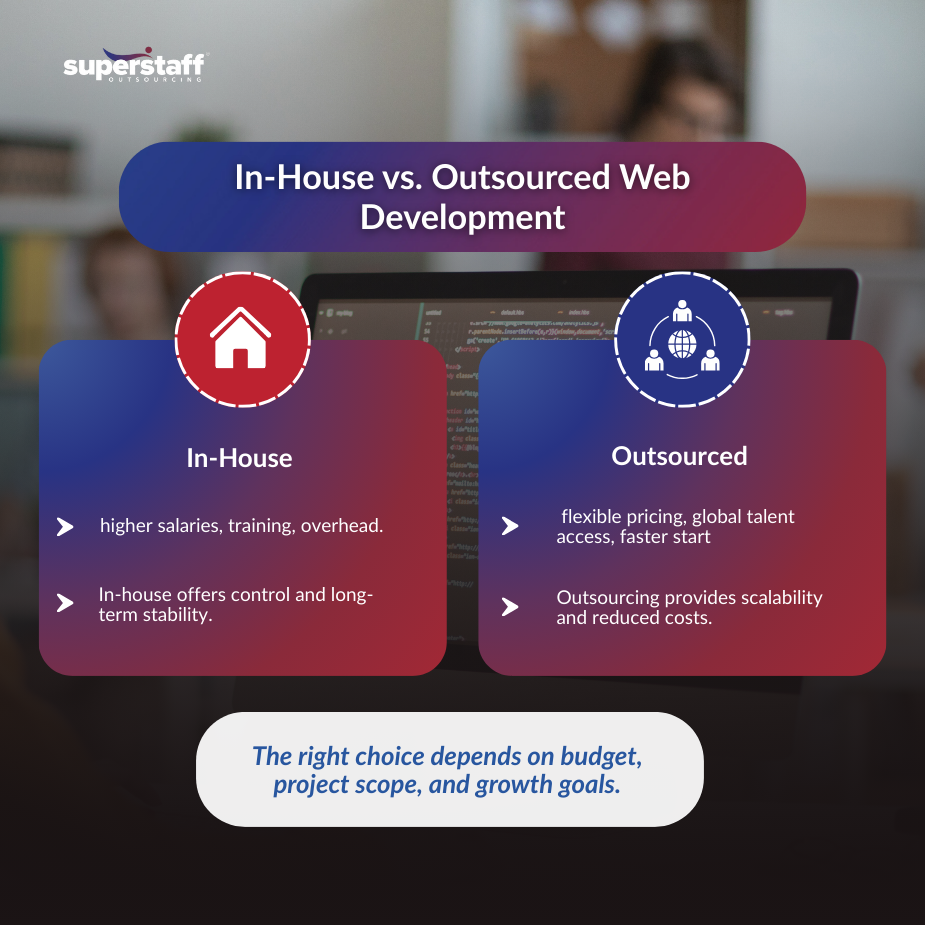
Businesses planning to expand online face a clear choice: build an in-house web development team or invest in outsourced web development. Both options come with unique advantages and costs, and the decision can shape how efficiently a company delivers websites, applications, and digital platforms.
Costs often become the main factor when choosing between models. Companies want skilled developers at reasonable rates, but they must also weigh scalability, project timelines, and operational flexibility. This article explores the cost comparison between in-house and outsourced web development, the benefits of each approach, and how organizations can decide which model works best for their growth strategy.

Why Businesses Compare Development Models
Companies evaluate their options because building and maintaining digital platforms requires continuous investment. The choice between in-house and outsourced web development often comes down to these main factors:
- Rising costs for tech talent in North America and Europe
- The need for faster project delivery without compromising quality
- Access to specialized skills that may be hard to find locally
- Flexibility in scaling resources up or down based on demand
- Long-term budget planning for sustainable growth
Cost Factors in In-House Web Development
Maintaining an internal team offers control but comes with recurring expenses. Below are the key costs businesses must prepare for when choosing an in-house approach.
1. Salaries and Benefits
Hiring skilled developers, designers, and project managers requires competitive pay. Salaries often make up the largest expense, especially in high-cost markets.
2. Recruitment and Onboarding
Finding the right talent takes time and resources. Businesses must also budget for onboarding and the risk of turnover.
3. Training and Upskilling
Technology changes quickly. Internal teams need constant training in new frameworks, tools, and coding practices, which adds to overall costs.
4. Tools and Infrastructure
Software licenses, project management systems, and IT infrastructure, such as servers and security, add up over time.
5. Office and Overhead Costs
If teams work on-site, businesses must cover office space, utilities, and equipment, further raising operational costs.
Cost Factors in Outsourced Web Development
Outsourced web development allows companies to partner with external vendors or freelancers. While it reduces some expenses, businesses must evaluate vendor models and hidden costs.
1. Pricing Models
Vendors may charge by the hour, per project, or through dedicated team arrangements. Each model affects cost predictability.
2. Regional Cost Differences
Rates vary widely across outsourcing hubs. Developers in Asia may cost less than those in Latin America or Eastern Europe, but differences in communication and quality must also be factored in.
3. Lower Overhead
Outsourcing removes expenses tied to office space, full-time salaries, and employee benefits.
4. Hidden Costs
Businesses should account for vendor management, communication delays, or rework if project expectations are unclear.
5. Scalability
One of the strongest advantages of outsourced web development is the ability to adjust team size based on project scope, allowing businesses to pay only for what they need.
Side-by-Side Cost Comparison
When evaluating the cost comparison between in-house and outsourced web development, these differences often stand out:
- Upfront Investment: In-house requires salaries, hiring, and infrastructure. Outsourcing usually begins with a contract or retainer fee.
- Ongoing Costs: Internal teams mean recurring expenses for payroll and training. Outsourcing allows flexible billing.
- Time to Market: Hiring internal teams takes months, while outsourced teams can start immediately.
- Scalability: Internal growth depends on budgets and hiring speed. Outsourced web development allows scaling without long-term commitments.
- Control: Companies with in-house teams maintain direct oversight, while outsourcing requires trust and coordination with vendors.
When In-House Makes Sense
An in-house web development team is often a better fit in the following cases:
- Continuous, long-term development needs within a company
- Businesses requiring strict security and compliance
- Projects needing constant oversight and deep integration with internal systems
- Large organizations with strong budgets to support payroll and infrastructure
- Companies aiming to retain full control over intellectual property
When Outsourcing Offers More Value
For many organizations, outsourced web development provides a more cost-efficient and flexible option. It works best when:
- Startups or SMEs need affordable yet skilled developers
- Businesses are working on short-term or project-based assignments
- Companies require specialized expertise, such as cybersecurity or advanced frameworks
- Scaling fast is more important than managing full-time staff
- Access to diverse global talent is a priority
Long-Term Considerations
The financial decision goes beyond immediate costs. Businesses must consider the following:
- Total Cost of Ownership: Internal teams have higher fixed costs, while outsourcing reduces long-term commitments.
- Risk Management: Outsourced teams may raise compliance concerns, while internal teams face risks of turnover.
- Innovation: Outsourcing IT services can give companies access to new tools and practices faster.
- Sustainability: Blending internal and outsourced models may create the most balanced and resilient approach.
SuperStaff’s Perspective on Web Development Outsourcing
SuperStaff helps businesses find the right balance between cost efficiency and high-quality development. With access to skilled developers across multiple regions, clients can scale their projects without the heavy overhead of in-house hiring. SuperStaff’s flexible models allow companies to choose outsourced web development for specific projects, ongoing support, or long-term partnerships, ensuring efficiency and measurable results.
Choosing between in-house and outsourced web development depends on a company’s budget, timeline, and long-term strategy. Both models carry benefits, but outsourcing often offers greater flexibility, reduced costs, and access to specialized skills.
Businesses should carefully assess their project needs and conduct a cost comparison between in-house and outsourced web development to determine which path delivers the best value. Partnering with experts like SuperStaff can help companies manage expenses, expand capabilities, and achieve growth through reliable outsourcing of IT services.






